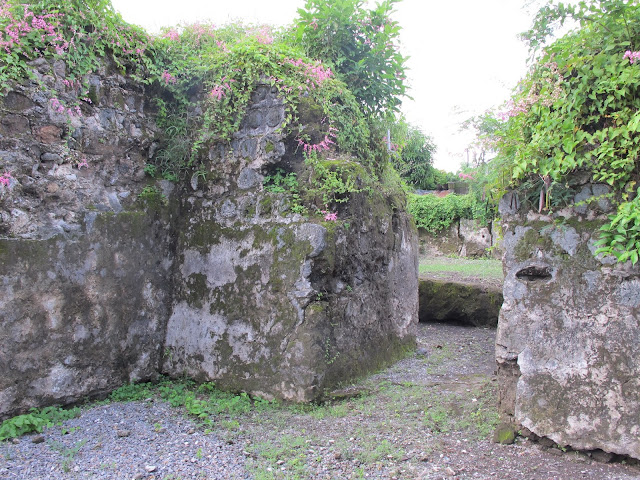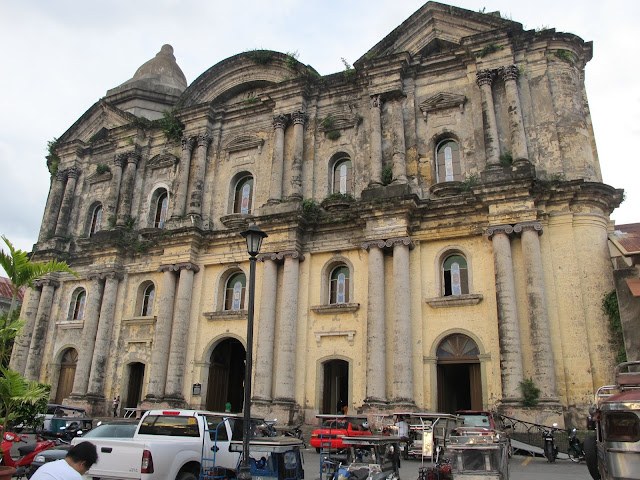Taal: Surviving with Grace
 |
| Old map of Taal from the Mexican Archives |
Unaware that Taal is the name of a genteel town filled with
heritage architecture, many people confuse it with Tagaytay. I guess it has to do with that magnificent
view. Mesmerized by the sapphire oval of water and its eruption-prone occupant,
many think of the City on the Ridge instead of the former capital of Batangas
province after which the lake itself is named.
In the 18th century , Taal actually stood right on
the shores of its namesake. A map I was recently given by the visiting director
of the Mexican Archives, Dr Aurora Gomez Galvarriato (who came to Manila
courtesy of her Embassy) revealed major settlements on the water’s edge where
there are none today. Apparently, the
lacustrine communities had been enduring the temperamental outbursts of the
tyrannical volcano for decades. The eruption of 1754 was so cataclysmic,
however, that the people finally gave up and moved away. All that remains are the ruins of the old church.
 |
| Ruins of the old church of Taal |
The town of Taal relocated to a site atop Caysaysay which
had, in the past, been a far-flung barrio. One can just imagine what such an
exodus must have entailed: It would have been a day darkened by the clouds of
ash covering the sun. In the distance was a glowing column of fire spewing from
the volcano, fearsome harbinger of death.
This terrible journey through a black abyss is actually
recorded in the words which accompany the Subli, a traditional dance that the
Batanguenos perform during special days. Despite the dangers, the Taal folk
pressed on, braving the stifling darkness to seek a new place for a new life.
 |
| Dancing the Subli |
I consider myself fortunate because I have had a chance to
witness how this life eventually flourished. As a boy, I had the pleasure of
being invited to spend weekends with the various members of the Laulhati Family
who are well-known citizens of Taal.
 |
| Old houses on Calle Real, Taal |
One of the Lualhati ladies, Mrs Herminia L. Alcasid is the
mother of Tony, a classmate of mine. Her
other son is the singer, Ogie Alcasid. Tony would bring me along during our
Holy Week breaks or at fiesta time in December.
Having grown up in the concrete barrios of Makati, I was
completely entranced with this cradle of culture: the three storey houses on
the plaza, the strange carved sea-stone arch in the middle of a forest, the
simple but glorious food. I also grew to
love the pageantry of the processions and the devotion which radiated from the
pabasa or readings of the Passion in front of the bloodied statue of the dead
Christ.
 |
| Basilica of Taal |
Through the years I would listen while Mrs Alcasid (or Tita
Minnie as we called her) endlessly discussed with her sister Mrs Ligaya Tankeh
(or Tita Aya) how to restore the town’s monumental temple, the Basilica of St
Martin. I recall how they regretted that one of the original wooden retablos
had been replaced by a cement construction and how concerned they were that the
pendentive paintings of the Four Evangelists had been lost. It seemed that
something else always needed fixing in this ancient community and the two
sisters never tired of rising to the occasion. While Tita Minnie was involved
with CHARM which focused on the church, Tita Aya headed the Taal Heritage
Foundation which covered practically everything else.
Under Tita Aya’s leadership, the Foundation acquired an old
house which was transformed into a bed and breakfast. So dedicated was this
admirable lady to her conservation work that she even braved a court case when
her right to use the house was challenged. I even remember , back in the days
when my own interest in heritage work
was just beginning, feeling so honored when Tita Aya invited me to a meeting
with former mayor Fe Cabrera to discuss historical preservation options for
Taal.
The Lualhati siblings were by no means alone in their task.
Later on I would meet Dindo Montenegro
who organized wonderful tours complete with craft showcases. There were
also the descendants of Dona Gliceria Villavicencio, who have restored the houses that this formidable
heroine of the Revolution had left them. Ernie Villavicencio worked with his
vivacious wife Ria who is an interior designer. The couple, together with the
current mayor, Michael Montenegro, would go on to found the Taal Alliance which
was dedicated to revitalizing their beloved town.
 |
| Craft demonstration |
Since its inception, the Alliance has undertaken many
important heritage programs such as a comprehensive cultural mapping of the
entire municipality. There are also plans to coordinate more closely with the
National Historical Commission headed by Dr Maris Diokno which runs two museums
in Taal. Meanwhile, Ernie’s cousin, Baby Joven Quiblat, with the full support
of her husband Benny, took on board Sonny Tinio as heritage house consultant.
With such a broad context of caring for the pieces of the
past, I was not at all surprised when my good friend, Tony, decided it was time
to restore his own ancestral home. Tita
Aya and Tita Minnie are the daughters of Mrs Conchita de las Alas Lualhati,
enterprising rural banker, Papal awardee and pillar of Taal society. Her
distinguished legacy includes a charming house a few steps away from the plaza.
Entering the newly refurbished Casa Conchita , I was happy
to see Tony’s creative touches everywhere. I smiled when I saw Lola Conch’s
portrait in rainbow colors a la Andy Warhol, festooned with kalachuchi
blossoms. Tony had ran a furniture factory in Indonesia
for many years and it was clear that the style that now pervaded Casa Conchita
was nothing less than Bali meets Batangas.
 |
| Lola Conchi |
 |
| Tony Alcasid inspects the buffet |
 |
| Ogie Alcasid, son of Taal |
Moving around, I saw that Tony had
carved out an arts gallery, a shop, and a café from what had once been a
storage area. Upstairs still retained the sleepy feeling that characterized the
house when Lola Conch was still alive – except for the gossamer orange curtains
which livened things up a notch. I was glad to see the dining set with its
carvings of Philippine scenes that were clearly by a Chinese hand.
Casa Conchita is just one of the many new establishments
opening in Taal. There is Ramon Orlina’s art gallery as well as Lito Perez’s
dining venue, Casa Tortuga. In the latter, one will find a photography studio
with period costumes. Singapore-based architect, Robert Arambulo has
refurbished a heritage home too – Casa Severina – which he opens to guests by
appointment. In recognition of his interest in the town, the mayor has named
him municipal tourism officer.
 |
| Casa Severina |
My visit ended at the Basilica were I was overjoyed to see
that the ceiling, long bare, had been restored. Even the pendentives sported
new images of the evangelists and best of all the original neo-Classical
retablo had been brought back. Taking in the splendor which surrounded me, I
suddenly found myself in tears. I felt such a deep sense of gratitude,
realizing that what I was seeing was the product of the sacrifice of the people
of Taal, descendants of those that had migrated here to rebuild their lives
with such grace.
Most of all, it was reassuring to know that long before
there was an Ivan Henares or an Ambeth Ocampo, there were already dear Tita
Minnie and dear Tita Aya, quietly pointing the way, patiently inspiring us all
with their love for the older places of this world which are so delicate and
yet so essential for understanding ourselves.
 |
| Interior of Taal Basilica |














































